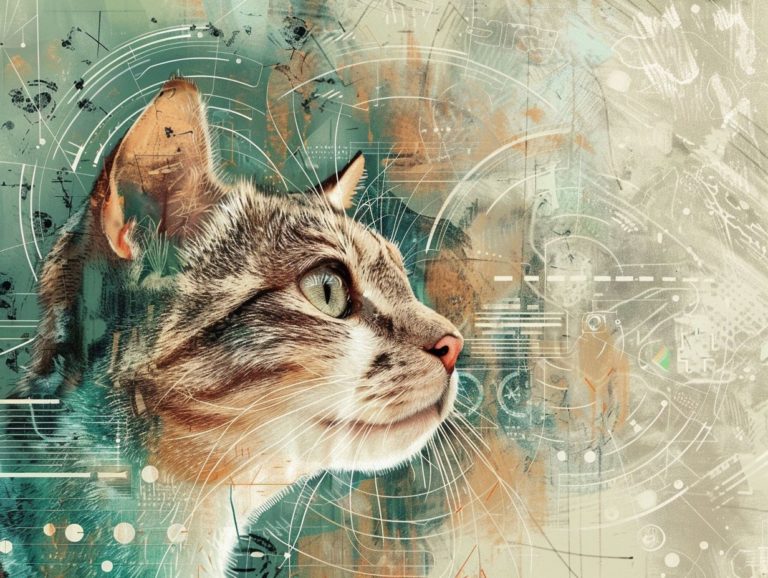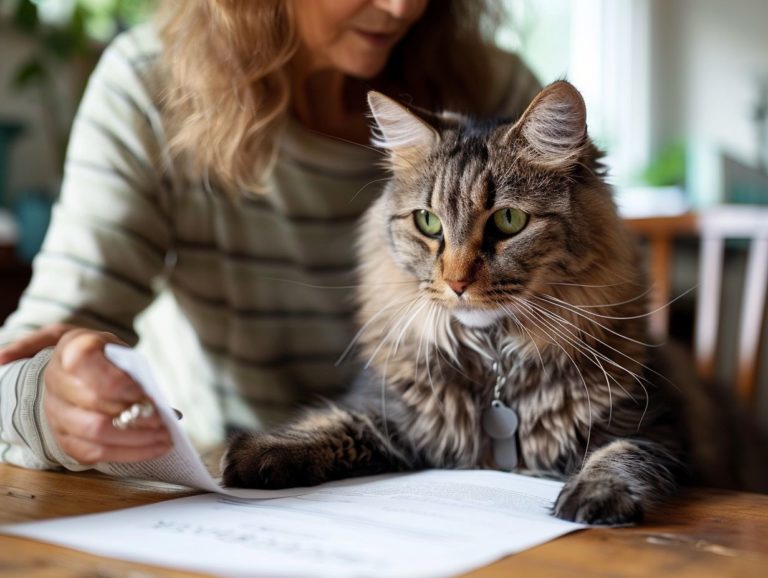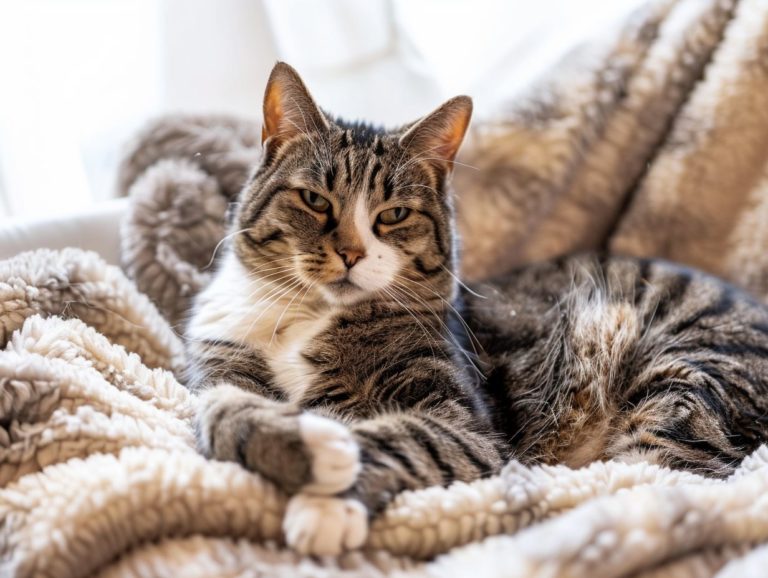Integrating Senior Cat Insurance Into Your Financial Planning
This article delves into the significance, various types, coverage options, costs, and purchasing factors of senior cat insurance. It also provides insights on incorporating it into your overall financial planning and strategies to reduce expenses.
Key Takeaways:
The Importance of Senior Cat Insurance
Senior cat insurance provides financial protection and healthcare for older pets, ensuring that an owner’s aging feline receives the necessary medical care and attention in its later years. This insurance plays a critical role in guaranteeing that aging pets receive the required medical care, covering or reimbursing the owner for some or all of the costs of care and medical treatments for cats aged 7 and above. This is crucial because cats over 7 are more susceptible to diseases such as arthritis, kidney disease, dental issues, and hyperthyroidism, and insurance can help mitigate the high expenses of veterinary care.
Senior cat insurance grants owners the financial flexibility to pursue recommended treatments, medications, and even emergency care without the worry of financial strain. This assurance and peace of mind enable pet owners to look after their aging cats with care and compassion, knowing that the financial aspects of their pet’s healthcare are managed.
Understanding the Needs of Aging Cats
To cater to the specific needs of aging cats, it is important to consider factors such as regular vet check-ups, monitoring for preexisting conditions, and providing a comfortable environment that supports their changing health requirements.
Senior cats may develop common health issues such as arthritis, dental problems, and kidney disease. Regular veterinary visits can aid in the early detection and management of these conditions. For instance, joint supplements and pain medications can help alleviate discomfort related to arthritis, while a specialized diet tailored to kidney function can assist cats with renal issues.
Establishing a quiet and easily accessible environment for senior cats, complete with soft bedding and strategically placed litter boxes, can enhance their quality of life and overall well-being.
Types of Senior Cat Insurance
Insurance options for senior cats include comprehensive coverage policies, wellness plans, and unique coverage options that can be customized to meet the specific needs of each senior cat. These insurance policies typically cover vet visits, treatments, medications, and preventive care depending on the chosen plan.
Comprehensive coverage policies offer extensive protection for senior cats, encompassing major medical expenses such as surgeries, long-term chronic conditions, and emergency care. Wellness plans, on the other hand, focus on preventive care services like vaccinations, annual check-ups, and dental cleanings.
Deductibles, the amount paid out of pocket before insurance coverage kicks in, can vary among plans and can impact premium costs. Reimbursement models may be flat rate or percentage-based, with some insurers offering an 80% reimbursement rate for medical services, while others provide a fixed $10 USD stipend for routine procedures.
Coverage limits define the maximum amount the insurance company will pay for specific treatments or procedures within a designated timeframe. Understanding coverage limits is essential for assessing the financial protection offered for your senior cat.
Coverage Options and Costs
When considering senior cat insurance, it is crucial to assess coverage options and associated costs. Different insurance plans offer varying premiums, deductible amounts, and reimbursement rates, leading to differences in overall costs.
Premiums play a significant role in determining the affordability of an insurance plan, representing the monthly cost paid by the owner in exchange for coverage of their pet’s medical expenses within the policy’s scope.
Another key factor to consider is vet bill coverage, which specifies the percentage of the cat’s medical expenses that will be reimbursed. This coverage is typically expressed as a percentage of the bill, with reimbursement rates of 70%, 80%, and 90% being common options.
The deductible amount is the portion of the veterinary bill that must be paid before insurance coverage kicks in. While deductibles are usually annual, some companies offer a per-incident deductible, necessitating payment for each separate incident where insurance coverage is utilized.
Opting for a lower deductible amount can increase the coverage of expenses, potentially offsetting the higher premiums of a comprehensive policy. A higher reimbursement rate and lower deductible contribute to increased coverage and reduced out-of-pocket costs for the owner.
By carefully examining these factors and comparing multiple insurance policies, pet owners can ensure comprehensive coverage for their senior cats without incurring excessive expenses.
Factors to Consider When Choosing Insurance
When selecting the optimal insurance for an older cat, it is essential to consider factors such as the cat’s age, health status, coverage requirements, budget limitations, and the owner’s overall financial planning objectives. This evaluation assists pet owners in identifying the most suitable insurance policy to maximize coverage and provide peace of mind for both themselves and their pets.
The ideal insurance policy for an older cat should account for the cat’s specific health conditions and any pre-existing conditions. Tailoring the policy to address these needs ensures that your pet’s healthcare requirements are met without placing excessive strain on your finances. Owners should also take into consideration their comfort level with the monthly premium cost and any potential deductibles to align coverage with their financial circumstances. For more information on customizing your senior cat’s insurance policy to fit their health needs, visit customizing your senior cats insurance policy.
Striking a balance between comprehensive coverage and cost-effectiveness enables pet owners to safeguard the well-being of their senior cat while managing expenses effectively.
Age and Health of Your Cat
The age and health status of senior cats are the two most important factors to consider when selecting insurance coverage for them. Older cats may be more costly to insure compared to kittens and younger adult cats due to age-related veterinary care expenses.
According to the North American Pet Health Insurance Association, pet owners tend to spend more on medical treatments for cats over the age of 10 than for those aged 1-3, as older cats require more frequent vet visits and specialized care, including surgeries, to address age-related conditions, injuries, and health issues that may necessitate ongoing medical attention.
Another cost-influencing factor in senior cat insurance is the breed of the pet. Various cat breeds have different predispositions to specific diseases, and insurance premiums are adjusted based on the likelihood of these conditions occurring. For instance, certain breeds like Maine Coons, Siamese, British Shorthairs, and Persians may be more prone to certain health issues, impacting insurance coverage considerations.
A pet owner’s awareness of their cat’s age and health condition is crucial in determining the appropriate insurance policy type and coverage levels. Regular preventative screenings and diagnostic tests are essential for older cats to enable veterinarians to identify age-related illnesses early and commence necessary treatments promptly. Age-specific insurance plans help offset the financial burden of such tests and treatments. Similarly, breed-specific policies cover ailments common to specific breeds as outlined in the insurance company’s underwriting guidelines. This proactive approach allows for timely detection and treatment of breed-specific conditions, ensuring that senior cats receive the required care without imposing financial strain on the owner.
Your Budget and Coverage Needs
To find the best insurance plan for your senior cat, it is crucial to assess your budget constraints and the coverage requirements. By considering deductible amounts, premium costs, and your overall financial status, you can identify the most comprehensive and financially sustainable policy for your financial planning needs.
The key lies in striking a balance between the desired level of coverage and your budgetary constraints when choosing the right insurance for your cat. It is important to find insurance that aligns with your financial situation while ensuring how senior cat insurance can save money for your senior cat’s healthcare needs.
Realistically evaluating your budget constraints enables you to prioritize aspects of your coverage plan. Opting for a higher deductible amount to lower premium costs, for example, can make insurance more affordable while still adequately covering your cat’s health requirements. Be sure to compare policies from multiple insurance providers to assess various coverage aspects and find a financially sustainable plan that effectively meets your senior cat’s care needs.
How to Integrate Senior Cat Insurance into Your Financial Planning
When incorporating senior cat insurance into your financial planning, it involves creating a pet savings fund, budgeting for vet bills and insurance premiums, and adjusting your overall financial plan to include potential unexpected healthcare costs for your aging cat.
By integrating insurance into your financial strategy, you can ensure your cat’s care without compromising your financial well-being. Establishing a dedicated pet account will help you save consistently for your cat’s healthcare needs in the future.
Keeping a close eye on veterinary expenses and estimating potential insurance costs will enable you to develop a practical budget. It is crucial to modify your overall financial plans to accommodate insurance premiums.
Having insurance for your senior cat will provide an additional layer of security for your long-term financial stability and offer peace of mind knowing you are prepared for any unforeseen medical expenses.
Calculating Costs and Budgeting
To prevent financial strain and ensure that your senior cat receives the necessary medical care, it is important to calculate the costs of senior cat insurance and incorporate them into your budgeting process. This involves budgeting for out-of-pocket expenses related to senior cat insurance and establishing a separate emergency fund for potential medical emergencies.
Understanding the details of your pet insurance policy, such as waiting periods and coverage limits, is essential for a smooth reimbursement process. Budgeting for senior cat insurance also means setting aside funds for veterinary services not covered by insurance and creating a dedicated emergency fund for unexpected medical costs.
Keeping track of all pertinent information about your pet insurance policy will facilitate prompt reimbursements. Effective cost management for senior cat insurance entails researching and selecting the most suitable policy for your cat’s needs within your budget. By being organized and proactive in budget management, you can ensure the best possible care for your senior cat.
Evaluating Insurance Providers
When considering insurance coverage for your elderly cat, researching and comparing different insurance providers is essential to determine the best policy. By comparing insurance policies, types of coverage, reimbursement procedures, and the reputations of various providers, you can make an informed decision that aligns with your cat’s healthcare needs and financial constraints.
Researching insurance companies allows you to understand the specific components of each policy, including coverage limits, deductibles, and any clauses related to pre-existing conditions. It is crucial to ensure that the chosen provider offers comprehensive coverage for common senior cat illnesses like arthritis or dental issues.
Additionally, examining the reimbursement procedures of potential insurance providers will help you determine how quickly you will be reimbursed for veterinary expenses. Opting for a reputable insurance provider known for timely payments and excellent customer service will ensure peace of mind and the best care for your aging feline.
Tips for Managing Senior Cat Insurance Costs
To effectively manage senior cat insurance costs, it is essential to maximize coverage benefits while minimizing unnecessary expenses and out-of-pocket costs. By employing cost-saving strategies, optimizing coverage limits, and maintaining a proactive approach to your cat’s health, you can ensure that insurance remains a valuable aspect of caring for your senior cat.
Regularly reviewing and updating your senior cat’s insurance policy is crucial as their healthcare needs evolve with age, helping to prevent unexpected costs. Taking preventive measures such as scheduling regular check-ups and providing proper nutrition can reduce the frequency of costly vet visits and treatments.
Additionally, establishing a veterinary emergency fund can serve as a financial buffer in case of an unforeseen emergency, reducing the dilemma of choosing between your pet’s health and financial stability.
Maximizing Coverage and Minimizing Expenses
For maximize insurance coverage for a senior cat, it is essential to understand insurance coverage limits, deductible amounts, and the reimbursement process to ensure your cat receives comprehensive healthcare. By minimizing out-of-pocket expenses and optimizing insurance benefits, a balance between financial security and pet care can be achieved.
Understanding coverage limits involves knowing the maximum reimbursement amounts for different conditions and treatments, as well as the maximum reimbursement amount per year. This knowledge helps cat owners identify insurance policies that provide the best protection for their cat’s specific health needs.
Knowing deductible amounts is crucial, as it represents the amount pet owners must pay before insurance coverage takes effect. Understanding these deductible amounts enables pet owners to grasp the out-of-pocket costs that need to be covered before insurance kicks in for medical expenses.
Understanding the reimbursement process includes knowing how quickly insurance companies reimburse for veterinary costs, the required documentation and forms, and how to initiate the reimbursement process. This knowledge helps pet owners receive insurance money for veterinary costs promptly.
Understanding the insurance policy details and exclusions is important. Knowing what treatments, conditions, and services are excluded from coverage, and understanding the policy’s fine print, helps pet owners anticipate what to expect when submitting a claim or seeking reimbursement. Awareness of exclusions such as pre-existing conditions, elective procedures, or hereditary conditions common in senior cats can help cat owners assess insurance policies more effectively and make informed purchasing decisions.
Regularly reviewing the policy and any changes or updates is recommended, as insurance companies can modify policies. Staying informed about policy changes can prevent surprises when making claims.
Keeping detailed records of veterinary visits and treatments is essential. Maintaining records of visits, treatments, medications, and invoices provides the necessary documentation for insurance reimbursements. Organized records streamline the claims process and reassure pet owners that they are maximizing their insurance coverage.
Frequently Asked Questions
What is Senior Cat Insurance and why should I consider integrating it into my financial planning?
Senior Cat Insurance is a type of pet insurance that provides coverage specifically for older cats. As cats age, they become more susceptible to health issues and require more frequent visits to the vet. Integrating senior cat insurance into your financial planning can help alleviate the financial burden of these increased healthcare costs.
What types of coverage does Senior Cat Insurance typically include?
The coverage included in Senior Cat Insurance varies depending on the insurance provider, but it typically includes accidents, illnesses, and preventive care. Some plans may also cover dental care and prescription medications.
When is the best time to start integrating Senior Cat Insurance into my financial planning?
The best time to start is when your cat is still young and healthy. This will ensure that pre-existing conditions are not excluded from coverage and you can lock in a lower premium. However, if your cat is already a senior, it is not too late to start integrating insurance into your financial planning.
Can I still get Senior Cat Insurance if my cat has pre-existing conditions?
It depends on the insurance provider and the specific condition. Some providers may offer coverage for pre-existing conditions, but they may come with certain limitations or exclusions. It’s important to research and compare different insurance plans to find one that best suits your cat’s needs.
How does integrating Senior Cat Insurance into my financial planning benefit me financially?
Integrating Senior Cat Insurance into your financial planning can help you save money in the long run. Rather than paying for expensive vet bills out of pocket, you can have the peace of mind knowing that your insurance will cover a significant portion of the costs. This can also help you avoid having to make difficult financial decisions when it comes to your cat’s health.
Are there any other benefits to Senior Cat Insurance besides financial security?
Yes, some Senior Cat Insurance plans also offer additional benefits such as lost pet recovery, coverage for boarding fees, and even alternative therapies like acupuncture or hydrotherapy. These extra benefits can provide added value for you and your senior cat.





